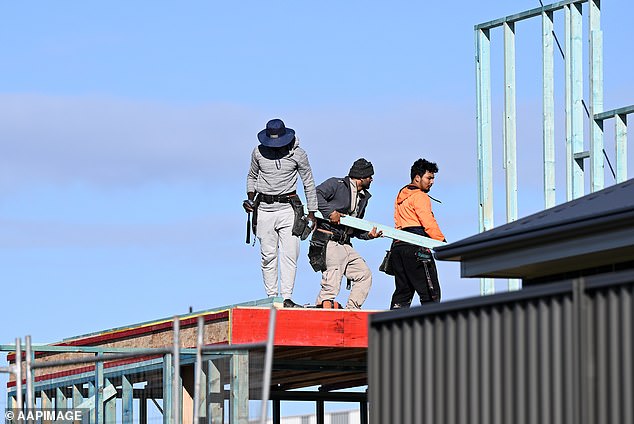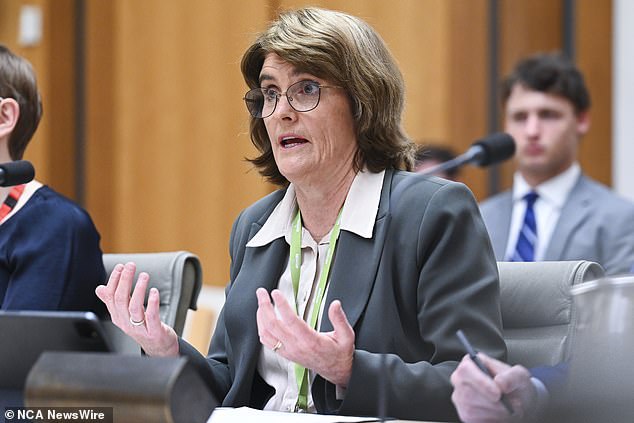The woman who decides the fate of millions of mortgage holders has declared that there will be no rate cuts anytime soon, despite what other countries have done this year.
Reserve Bank Governor Michele Bullock told a parliamentary hearing on Friday that Australia would not copy the approach of other central banks that have cut rates this year, with New Zealand offering some relief this week.
“Financial markets are still pricing in a rate cut here in Australia by the end of the year,” he told the House of Representatives economics committee in Canberra.
‘The board’s message, however, was that it is premature to think about rate cuts: inflation is still too high and in underlying terms is not expected to return to the top of the band until late next year.
‘Based on what the Board currently knows, it does not expect to be in a position to cut rates in the near term.
“I understand that this is not what households want to hear: those with mortgages are feeling the pressure on their cash flows due to rising interest rates over the past two years.”
The Reserve Bank of New Zealand this week cut interest rates for the first time since 2020, following the approach of its counterparts in Canada, the European Union and the United Kingdom.
But Ms Bullock also argued that did not mean other central banks would start cutting rates aggressively.
Reserve Bank Governor Michele Bullock told a parliamentary hearing on Friday that Australia would not copy the approach of other central banks that have cut rates this year, with New Zealand offering some relief this week.
“Other central banks remain cautious about the future direction of interest rates,” he said.
‘Some have cut their policy rates slightly, but have stressed that the job is not done yet and that policy remains restrictive.’
While Australia’s cash rate of 4.35 percent is at its highest level in more than 12 years, it is lower than New Zealand’s 5.25 percent, the United Kingdom’s 5 percent and Canada’s 4.5 percent.
These central banks, together with the European Union, have cut interest rates this year.
“The same is true here in Australia: we don’t raise interest rates as much as other central banks and we’ve had some criticism for that,” he said.
Warwick McKibbin, a former RBA board member and now a professor at the Australian National University, has suggested the Reserve Bank would need to raise rates three more times to 5.1 per cent, a level last seen in 2008 before the global financial crisis.
“Indeed, some commentators continue to call for further monetary policy tightening,” Bullock said.
“We have been trying to strike a balance between reducing inflation over a reasonable period of time and without inflicting unnecessary damage on the labor market.”

While Australia’s cash rate of 4.35 percent is at its highest level in more than 12 years, it is lower than New Zealand’s 5.25 percent, the United Kingdom’s 5 percent and Canada’s 4.5 percent.
This month, the Reserve Bank left interest rates unchanged but published new forecasts predicting that underlying inflation (excluding volatile price items) would not reach the full extent of the RBA’s 2-3 per cent target until the end of 2025.
Unemployment hit a two-year high of 4.2 percent last month as the most aggressive interest rate hike since the late 1980s caused insolvencies to surge to record levels.
Ms Bullock said the Reserve Bank would look to improve its forecasts, after her predecessor Philip Lowe said in 2021 that rates would remain at a record low of 0.1 per cent until 2024 “at the earliest”.
Instead, borrowers suffered 13 rate increases in 2022 and 2023 that led to a 68 percent increase in monthly variable mortgage payments.
“We need to be willing to learn from our mistakes,” Bullock said.
Headline inflation, also known as the consumer price index, rose to 3.8 percent in the year to June.
Ms Bullock said construction costs were included in the CPI, which also meant Australia had higher goods inflation.
“There is a shortage of skilled workers, so their costs are rising and there are costs, particularly of energy-intensive products like concrete, that have also contributed to housing construction costs,” he said.
“All of those factors have meant that construction costs have continued to rise in Australia, they’re in our CPI and that has meant that our property price inflation has been a bit higher than overseas.”

Ms Bullock said construction costs were included in the CPI, which also meant Australia had higher goods inflation.

